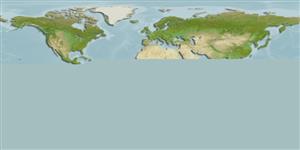Common names from other countries
Environment: milieu / climate zone / depth range / distribution range
Ecologie
marien; diepte 0 - 50 m (Ref. 189). Tropical; 2°S - 20°S, 174°E - 171°W (Ref. 189)
Central Pacific: Fiji and Samoa.
Grootte / Gewicht / Leeftijd
Maturity: Lm ? range ? - ? cm
Max length : 7.5 cm SL mannelijk / geslacht onbekend; (Ref. 128118)
This species is distinguished by the following characters: gill rakers on first gill arch, upper series 20-24 (modally 21), lower series 27-30 (29), total 48-53 (50); gill rakers on second gill arch upper series 14-17 (15), lower series 25-30 (26), total 40-47 (41); gill rakers on third gill arch, upper series 11-13 (12), lower series 13-16 (15), total 24-29 (26); gill rakers on fourth gill arch, upper series 8-10 (8), lower series 10-13 (12), total 19-22 (20); prepelvic scutes 2-5 (4); upper jaw long, its posterior tip slightly short of or just reaching to posterior border of preopercle; predorsal scutes absent; pelvic scute no spine; posterior border of preopercle convex, rounded; parietal and occipital regions with obscure paired dark patches, without following dark lines; no black spots below eye and lower-jaw tip; body relatively elongate, its depth 17.0-20.0% of SL (mean 18.7%); anal-fn base long, its length 20.2-23.3% of SL (21.2%); caudal peduncle relatively short, its length 14.4-18.3% of SL (16.4%); posterior tip of pelvic fin reaching to the second–fifth dorsal-fin ray origin (Ref. 128118).
A schooling species in shallow coastal waters. Used as bait in the tuna fishery in the South Pacific, although rare in bait catches in Fiji and Samoa.
Levenscyclus en paargedrag
Maturities | Voortplanting | Spawnings | Egg(s) | Fecundities | Larven
Hata, H. and H. Motomura, 2018. Stolephorus insignus, a new anchovy from the western Pacifc, and redescription of Stolephorus apiensis (Jordan and Seale 1906) (Clupeiformes: Engraulidae). Ichthyol. Res.1-9. (Ref. 128118)
Status op de Rode Lijst van het IUCN (Ref. 130435)
CITES (Ref. 128078)
Not Evaluated
Gevaar voor de mens
Harmless
Gebruik door de mens
Visserij: commercieel; aas: usually
Tools
Speciale rapporten
Download XML
Internetbronnen
Estimates based on models
Preferred temperature (Ref.
115969): 27 - 27.7, mean 27.2 (based on 8 cells).
Fylogenetische diversiteitsindex (Ref.
82804): PD
50 = 0.5000 [Uniqueness, from 0.5 = low to 2.0 = high].
Bayesian length-weight: a=0.00562 (0.00259 - 0.01222), b=3.18 (3.00 - 3.36), in cm Total Length, based on LWR estimates for this (Sub)family-body shape (Ref.
93245).
Trofisch niveau (Ref.
69278): 3.3 ±0.4 se; based on size and trophs of closest relatives
Weerstandsvermogen (Ref.
120179): Hoog, minimale populatieverdubbelingstijd minder dan 15 maanden (Preliminary K or Fecundity.).
Fishing Vulnerability (Ref.
59153): Low vulnerability (10 of 100).
